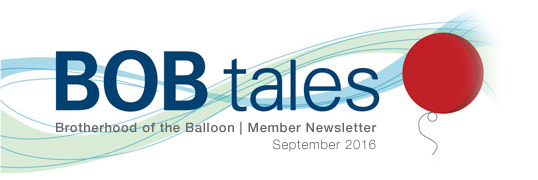
.jpg)
Dear Members:
When we first started publishing our monthly newsletter almost 16 years ago, one of my biggest concerns was that we would run out of material to write about. In fact, just the opposite has been the case. There are so many new developments with prostate cancer and proton therapy that the problem we face is what to include each month and what to leave out.
Several years ago, we reported that the United States Preventive Service Task Force (USPSTF) had taken a strong position against prostate cancer screening. Many doctors, as well as the general public, took that directive seriously and stopped PSA testing and digital rectal exams. This month we are reporting on a recent study that shows a sharp rise in the diagnosis of deadly metastatic prostate cancer, which researchers believe may be connected with the reduction in screening.
When we formed the BOB in 2000, prostate cancer testing was essentially limited to the PSA test and digital rectal exam. In recent years, new imaging testing, as well as extremely accurate blood testing techniques, are allowing doctors to more precisely determine the extent and aggressiveness of prostate cancer. As a result, more information is available to help determine whether active surveillance, aggressive treatment, or something in between is appropriate for each patient. This month’s BOB Tales examines this subject in some detail. This information should be of value to family members and friends who may someday be dealing with prostate cancer.
We continue to learn more about over-the-counter medications, vitamins, and supplements, some of which can help prevent prostate cancer or help prevent a recurrence, and others that can contribute to complications after treatment. These too, are covered in this month’s BOB Tales.
Deb and I subscribe to numerous cancer and health-related publications. We also read and discuss the latest books on cancer prevention and detection. One book that caught our attention is “Anticancer—A New Way of Life,” by David Servan-Schreiber, MD, PhD.
The book was written by a young physician and scientist who was diagnosed with a deadly brain tumor. Rather than sit back and let cancer take his life, he fought the disease vigorously. He writes about the latest research on anticancer foods—what to eat and what not to eat; how vitamin D strengthens the immune system; common food contaminants that have been proven to contribute to cancer progression; the role of stress in cancer progression; lifestyle modifications to prevent or slow cancer progression, and much more.
Deb and I read three chapters each week and then discussed what we learned. We feel this book is so important; we plan to run a series of articles beginning next month. We are hoping you will not only open and read this series, but also forward it to others who may benefit from reading it.
Lastly, September is National Prostate Cancer Awareness Month. This is a good time to reflect on what we all have in common and what brought us together. It’s a time to remind ourselves of how blessed we are to have discovered proton therapy, a treatment option that has left the overwhelming majority of us cancer free and with a high quality of life after treatment. And it’s also a good time to remind our close male relatives of the prostate cancer family connection and the importance of early detection.
I hope you enjoy this month’s newsletter. As always, we welcome your feedback and suggestions for future newsletters. Just send an email to [email protected].
Bob Marckini
To print the BOB Tales newsletter or view the newsletter with a larger font size, click here for the PDF file.
In This Issue:
- Metastatic prostate cancer cases skyrocket
- Opko 4K Score prognostic blood test: Breakthrough technology!
- New research links vitamin D deficiency to prostate cancer
- NSAIDs may contribute to rectal and urinary bleeding
- The promise (and limits) of pediatric proton radiation
- Heart attack patients younger/more obese
- Sudden cardiac arrest not always sudden
- New “Live It” video: More on colon cancer prevention
.jpg)
Opko 4K Score Prognostic Blood Test: Breakthrough Technology!
“Do no harm…” That’s a tenet of the Hippocratic Oath, but unfortunately, this doesn’t always prevail. If routine screening shows that your PSA and/or DRE are abnormal, it is important to decide whether to have a biopsy performed. Frequently, men in this situation are encouraged to follow up with a biopsy, and this can lead to many downstream problems.
.jpg) According to Dr. S. Punnen et al., “Prostate biopsy is an invasive procedure with significant complications, such as bleeding, urinary retention, and life-threatening infection. A recent population-based study from Ontario, Canada, revealed a fourfold increase to 4.1 percent for the rate of hospital admissions after prostate biopsy from 1996 to 2005, with 72 percent of admissions being due to infection.” This problem, along with the risk of overtreatment and ensuing problems, led the U.S. Preventive Services Task Force in 2008 to recommend against PSA-based screening altogether, to reduce over diagnosis and overtreatment.
According to Dr. S. Punnen et al., “Prostate biopsy is an invasive procedure with significant complications, such as bleeding, urinary retention, and life-threatening infection. A recent population-based study from Ontario, Canada, revealed a fourfold increase to 4.1 percent for the rate of hospital admissions after prostate biopsy from 1996 to 2005, with 72 percent of admissions being due to infection.” This problem, along with the risk of overtreatment and ensuing problems, led the U.S. Preventive Services Task Force in 2008 to recommend against PSA-based screening altogether, to reduce over diagnosis and overtreatment.
Unfortunately, this leaves many men at risk of the disease progressing to a much more advanced state before being detected, with a reduced chance of cure, so this is a very unsatisfying approach. This year, about 27,000 men will die of prostate cancer in the U.S. alone.
Clearly, there is a need for a better means of deciding whether to have a biopsy and perhaps treatment.
New Test Predicts Aggressiveness of Cancer—a Major Benefit
Now, there is a simple, affordable prostate cancer-specific blood test that enables you to know with a high degree of certainty whether you have indolent (non-aggressive) or aggressive disease. It can help you determine whether you can safely monitor your situation without significant risk, or whether you should consider having a biopsy and possibly immediate treatment. The Opko 4k score test, developed at Memorial Sloan Kettering, is available to assist men in this situation. This test has been validated over the past 10 years and it has been shown to have a very high degree of accuracy.
A comparison of the 4k score prediction with actual biopsy results performed during validation trials referenced in the Punnen et al. study shows an extremely high correlation. Furthermore, the test has high predictive value re: the chance to be without prostate cancer metastases within 20 years. It is the only blood test that accurately identifies the risk of aggressive prostate cancer. This test has the potential to reduce the number of prostate biopsies performed in the U.S. alone from 1 million to about 600,000, with a commensurate reduction in pain, suffering and cost.
Used Only for Undiagnosed Men
It is important to note that the test follows NCCN (National Comprehensive Cancer Network) guidelines and is intended only for men who have had no prior biopsy or negative biopsies. At some point, it may also be used to assist men who have Gleason 6 early-stage disease indications. So, if you, a friend or family member have an indication of a potential problem, it might be wise to ask your primary care physician or urologist to consider administering the Opko 4k test (Be sure the blood sample is taken before the DRE or at least 72 hours afterwards to avoid a misleading result.).
Visit the Opko 4K test website for more information about the test as well as insurance coverage for this test. For more information on insurance coverage, you may also call 1-855-452-4554.
Metastatic Prostate Cancer Cases Skyrocket
In 2008, the U.S. Preventive Service Task Force (USPSTF) recommended against PSA testing purportedly because prostate screening has led to over-treating of tens of thousands of men with slow-growing prostate cancers, many of whom needed no treatment at all. Many physicians and patients took this recommendation seriously and stopped prostate screening.
The Real Problem
Our position on this issue has consistently been that the problem is not PSA testing, it’s what was being done after the PSA test. A high percentage of men with indolent (slow to develop) prostate cancer were being hastily directed to various forms of treatment leading, in many cases, to severe side effects including impotence, incontinence, infection, and even death.
We have said all along, that the problem is not over testing, it’s over-treating. Active surveillance is a viable course of action for men with early stage, slow-growing prostate cancer. Our position has been that the USPSTF’s recommendation of terminating prostate screening could lead to a growing number of undiagnosed, aggressive prostate cancers that, if left untreated, could result in metastasis and death.
More Aggressive Disease on the Rise
The media were flooded with reports last month about a Northwestern Medicine study which reported a 72 percent increase in new cases of metastatic prostate cancer in the past 10 years. The study was published in Prostate Cancer and Prostatic Diseases on July 19.
The Northwestern research team analyzed information on more than 767,000 men from more than 1,000 facilities nationwide who had been diagnosed with prostate cancer over a 10-year period. More recently, men who presented with metastatic disease had much higher PSAs than similar men 10 years prior. This is an indication that more aggressive disease is on the rise, according to the study.
The study’s senior author is Dr. Edward Schaeffer, chairman of urology at Northwestern University Feinberg School of Medicine and Northwestern Medicine. He believes the sharp increase in metastatic prostate cancer diagnoses is due to both the rise in aggressiveness of prostate cancer and the decline in prostate cancer screening. “If I were a patient, I would want to be vigilant. I firmly believe that PSA screening and rectal exams save lives,” says Dr. Schaeffer. And we agree.
Early stage prostate cancer has a survival rate of about 100 percent. But late-stage metastatic disease has a five-year survival rate of only 28 percent, according to the American Cancer Society.
New Imaging Tests Show Promise
With the development of new imaging tests, such as 3-Tesla MRI, C11 Acetate, and Choline PET Scanning, and other tests, like the Opko 4k blood test, it is becoming much easier for doctors to determine the extent and aggressiveness of newly diagnosed cancers. This allows patients, working with their doctors, to choose the best path forward, which might be active surveillance (watchful waiting) for early stage, non-aggressive cancers or medical treatment for more aggressive cancers.
This study is a serious reminder that each of us needs to be proactive in taking responsibility for our health, and to make decisions on routine testing and screening based on what is in our own best interest.
Articles based on this study can be found in Newsweek, Fox News Health, and CBS News.
New Research Links Vitamin D Deficiency to Prostate Cancer
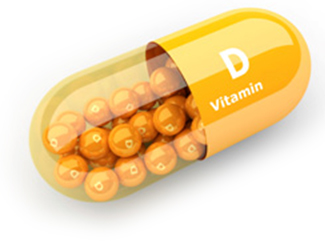 We have long known that maintaining vitamin D levels in the high end of the normal range can help prevent prostate cancer and also help prevent a recurrence of prostate cancer. New research has shown that low levels of vitamin D can predict aggressive prostate cancer. This is according to Adam Murphy, assistant professor of urology at Northwestern University Feinberg School of Medicine, Chicago, and lead investigator on the study, published in the Journal of Clinical Oncology. The study shows a direct correlation between vitamin D levels and aggressive prostate cancer.
We have long known that maintaining vitamin D levels in the high end of the normal range can help prevent prostate cancer and also help prevent a recurrence of prostate cancer. New research has shown that low levels of vitamin D can predict aggressive prostate cancer. This is according to Adam Murphy, assistant professor of urology at Northwestern University Feinberg School of Medicine, Chicago, and lead investigator on the study, published in the Journal of Clinical Oncology. The study shows a direct correlation between vitamin D levels and aggressive prostate cancer.
The study followed 190 men who underwent a radical prostatectomy between 2009 and 2014. Eighty-seven men from that group had aggressive prostate cancer, and their vitamin D levels were all significantly below the normal level of 30 ng/ml. Most physicians suggest a vitamin D blood level target of at least 35 to 40 ng/ml.
Murphy feels that men should monitor their vitamin D levels because vitamin D is also a biomarker for bone health and aggressiveness of other diseases.
Read the HealthSite article titled, “Vitamin D Deficiency Can Cause Prostate Cancer.”
NSAIDs May Contribute to Rectal and Urinary Bleeding
.jpg) In a recent video blog, Dr. Charles Snuffy Myers draws attention to the potential risk of using aspirin, especially when you combine it with NSAIDs such as ibuprofen (Advil, Motrin) or naproxen sodium (Aleve), which he indicates can act as powerful blood thinners.
In a recent video blog, Dr. Charles Snuffy Myers draws attention to the potential risk of using aspirin, especially when you combine it with NSAIDs such as ibuprofen (Advil, Motrin) or naproxen sodium (Aleve), which he indicates can act as powerful blood thinners.
It is not uncommon for some men who’ve had proton therapy (as well as IMRT) to experience rectal bleeding, typically beginning about a year after completing treatment. Some men also experience radiation cystitis and can have blood in their urine (hematuria). These effects can become severe and even lead to anemia. If you are encountering either or both of these, be sure to discuss use of these agents with your physician as a possible contributor to the bleeding. Dr. Myers cautions us to make sure we have a valid reason for using even low-dose aspirin as a part of our supplement regimen and to use it only as warranted upon the advice of a physician.
Recently, we heard from one of our members who was experiencing hematuria. When he stopped taking NSAIDs the problem went away. He followed up with his doctor and had testing to ensure the bleeding wasn’t from any other cause.
The Promise (and Limits) of Pediatric Proton Radiation
 The brain is the most common area for children to develop cancerous tumors, according to Dr. Torunn Yock, director
The brain is the most common area for children to develop cancerous tumors, according to Dr. Torunn Yock, director
of pediatric radiation oncology at Mass General Hospital and an associate professor at Harvard Medical School. And, childhood brain cancer is considered one of the most evidence-based uses for proton therapy because it may prevent side effects such as hearing loss or sight impairment as well as problems with overall growth development.
Although proton therapy may not offer a higher probability of cure than traditional X-ray radiation, there is a clear advantage to not irradiating healthy brain tissue. The pediatric brain is still developing, so if healthy tissue is exposed to radiation during treatment, it won’t continue to grow and develop normally.
With traditional radiation to the brain, the radiation scatters. This exposes large areas of the brain to low doses of radiation, and even low doses can be harmful. With proton therapy, not only is healthy tissue spared, doctors can use a higher dose than traditional X-ray radiation to treat resistant tumors.
“There are certain brain tumors in children where we have to treat the entire brain and spine,” says Dr. Thomas Merchant, chairman of radiation oncology at St. Jude Red Frog Events Proton Therapy Center. “If we use proton therapy, we don’t have exit radiation into the chest and abdomen that you have when you treat someone with conventional radiation.” That may reduce long-term side effects in the heart and lungs.
And with pencil beam scanning—which conforms or shapes the highest-dose radiation to the targeted tumor—it’s possible to reduce the margin area around the tumor exposed to radiation. This may eventually have the potential to reduce the risk of secondary cancers.
Future fertility is also a factor in cancer treatment planning. In cases involving radiation around the pelvic area, it’s possible with proton therapy to avoid the ovaries in a young girl or the testicles in a boy.

Recap: BOB Reunion, Jackson Hole, WY
On July 12, a small group of BOB members met at Nani’s, a popular Italian restaurant in Jackson, WY to meet with Lynn Martell, D.Min, Director of Special Services at Loma Linda University Health, and connect with fellow former proton patients.
Dr. Martell shared some updates on Loma Linda University Health’s Vision 2020 and recent developments in proton therapy. Attendees shared fond memories of their healing experiences at LLUCC and expressed appreciation for the medical center’s emphasis on treating the whole person—body, mind, and spirit. They also spoke about the benefits of using the Drayson Fitness center and other surrounding amenities.
Pictured below beginning on the left, clockwise: John Miller, Dr. Marty Quadland, Paula Quadland, Bobbi Miller, Lisa Robertson, Karen Martell, Steve Robertson and Dr. Lynn Martell.
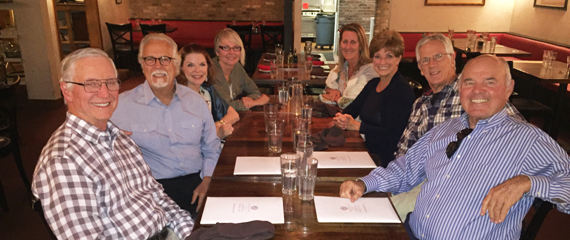

Member/Prospective Member Feedback
We love hearing from our members. Have something to say? Send an email to Deb Hickey. Following are a few messages we’ve recently received.
Deb, I have to say, I am surely impressed with the [BOB] website. I just went in to update my profile with my latest PSA reading (just celebrated 5 years post-treatment with a PSA of 0.34!). Anyway, I was blown away by the state-of-the-art website you have put together. I downloaded the BOB PowerPoint presentation and was again blown away by how professional and informative it is. I used your first draft slideshow four years ago and this version is WAY better. I can’t wait to share it with another group of men at church/work or wherever I can assemble them.
I’m 54 years old now and feeling wonderful.
Thank you and your father for all you do in spreading the word and educating the world on the benefits of proton therapy.
Warmest regards,
—Joel T. Buice, BOB Member
We also often receive messages from prospective members thanking us for our help. These touch our hearts and reconfirm daily our reasons for doing what we do.
Many thanks for your quick responses to all of my questions. I really appreciate it so much. For me, the work you do is comparable to that of a missionary helping others in distress and seeking guidance.
The best to you and to those you care about.
—Prospective Proton Patient
The Power of Facebook
 Facebook offers us the opportunity to interact with an extraordinarily expansive universe of people well beyond our community of 8,000-plus members. Over the past few years, our “fanbase” has reached more than 800. Each week, our posts are “liked” and shared more and more. As a result, this month, one of our posts reached nearly 3,000 Facebook users.
Facebook offers us the opportunity to interact with an extraordinarily expansive universe of people well beyond our community of 8,000-plus members. Over the past few years, our “fanbase” has reached more than 800. Each week, our posts are “liked” and shared more and more. As a result, this month, one of our posts reached nearly 3,000 Facebook users.
Fans, mostly members, their significant others and family members, often comment about their experiences and congratulate the milestones and accomplishments of the members we write about. Every time a BOB fan likes, shares, or comments on one of our posts, our stories and their messages are seen by thousands of others in the Facebook community—others who may have never heard of proton therapy or are unaware that such an organization of prostate cancer survivors exists.
Why do we have a Facebook page? To connect directly with members, their family, and their friends in real time, as well as friends of our Facebook friends, thus connecting with their Facebook friends and their Facebook friends (and so on). We are able to leverage our proton message exponentially through this social media platform. If you are not on Facebook, please join and become a BOB fan. If you are already on Facebook, visit the BOB page and click the “like” button to become a fan. Encourage your friends to do the same. Please help us spread the word about proton therapy.
Following are a just a few of many recent Facebook comments by BOB fans.
In response to profile post about BOB member, Chuck Bloodgood:
- “August 3, it will be 12 years since my husband started treatment for prostate cancer at Loma Linda. He started with a PSA of 13. It has stayed at 0.07 with no side effects. We thank LLUCC every day!”
In response to article post, "Metastatic Prostate Cancer Cases Skyrocket:"
- “We praise God we learned about proton treatment when my husband was diagnosed with prostate cancer. The treatment was completely painless, almost no residual problems, and totally successful!”
- “Do not fear the diagnosis … treat it with pain-free proton therapy … Seven years and still here with no fear and no pain.”
In response to profile post about BOB member, Jacques “Frenchy” Houot:
- “I am 52 years old going through proton therapy right now in Illinois. I hope I can be this active at 80!! Great job, Frenchy—you are an inspiration!”
- “57 (soon to be 58) year old firefighter/paramedic … just finished proton treatment at the Seattle Cancer Care Alliance and didn’t miss a day of work. Frenchy, you’re a rock star, bud!”
- “I was treated at Loma Linda with proton therapy for my prostate cancer in 2005. I’m still cancer free today. I will be 78 on August 26.”
In response to article post, “Proton Therapy: Is it worth it?”
- “Is it worth it? Are you kidding me? My dad is cancer free and living a wonderful life because of it. Of course it is worth it.”
- “I’m a survivor. Thank you, God and LLUCC. You guys are great! Keep up the good work.”
- “I thank my lucky stars that I was treated with proton therapy in 2007 … It’s sad that the debate continues about proton therapy because of the high cost. It has been proven to be the best, safest, and least invasive treatment.”
.gif)
We have been producing BOB Tales newsletters monthly for almost 16 years. During this time there have been some important articles that many new members have not seen, and some older members may have forgotten. So, we decided to periodically re-run some articles from past newsletters.
Here’s one from our March 2003 BOB Tales, more than 13 years ago:
New Members: Is There a Message Here?
We added 42 members in February and lost one. A gentleman from New York was scheduled for proton treatment, but changed his mind and elected seeds plus EBRT because he couldn’t be away from his home and work for eight weeks. We wish him luck. We ended February with 819 members.
Two of our newest members send a strong message about the efficacy of proton treatment. One is a physician/cancer researcher from Huntington Beach, CA. Another is a urologist from Billings, MT. What does this tell us about the treatment we chose? I think it sends a strong message when cancer researchers and urologists choose proton therapy.
Add to that the many physicists in our group. Who understands particle accelerators and the unique cancer-killing characteristics of protons better than a physicist? On top of that, we have numerous clergy and airline pilots in our group—and we all know no people are closer to the “Man Upstairs” than they are. So, no matter how you look at it, I think we made the right treatment choice.

Please Consider Giving to the Robert J. Marckini Endowed Chair for Proton Therapy Research
A few years ago, Loma Linda University Health (LLUH) honored Bob Marckini by establishing an endowed chair in his name. Endowed chairs are associated with the best universities around the world. When chairs are “endowed,” funds are raised and invested in order to generate annual income from which salaries and expenses for research are allocated. At LLUH the target for an endowed chair is $5 million. This is the level that can provide funding to support a research scientist and assistant along with expenses connected with the research effort, including travel, equipment and supplies.
Endowments are far more desirable than grants, because with grants, researchers must spend up to 60 percent of their time working on writing grants, leaving only about 40 percent of their time to do research. Endowments free up the researcher to do research and the benefits to patients are far greater. According to Dr. Jerry Slater at Loma Linda University Cancer Center (LLUCC), with endowments, the research team is at the wheel and they have much more control of the scope, direction and pace of the research.
Marckini Chair Now at $3 Million!
We were pleased to learn recently that thanks to contributions from our members the Marckini Endowed Chair has reached $3 million and is actively being used to fund important proton therapy basic and clinical research.
In addition to several prostate cancer clinical research programs, research under way at LLUCC includes treating AVMs or arterial venous malformations (brain bleeds), where a single application of protons can cauterize blood vessels in the brain, eliminating the need for highly invasive surgery to the skull and brain cavity. This is especially beneficial in treating young children, where AVMs are most common.
Other efforts involve adding resources to shorten the time to analyze and publish recently completed clinical trials, facilitating the implementation of new clinical trials, expanding the scope of research projects, including additional applications of proton therapy for treatment of women and children.
You can support all these efforts by making a contribution to the Robert J. Marckini Endowed Chair. You can do this by sending a check by mail or using a credit card and making a gift online. Many members have designated a portion of their estate plan to go to the Marckini Chair after their passing. You can also make gifts of assets, such as appreciated stock, land or other assets.
We feel that one of the best ways of saying “thank you” for the gift we have received is to give back. And contributing to proton research is a wonderful way to give back.
How to Contribute to Proton Research
Give Now: Visit the LLUH website and donate online. Make sure the “Designation Type” is set to “Proton” and the “Designation” is set to “Robert J. Marckini Chair.
Send a Check: Make your check out to “LLUCC Proton” with “Marckini Chair” in on the memo line and send to:
LLUH, Office of Philanthropy
P.O. Box 2000
Loma Linda, CA 92354.
Make a Call: Contribute by phone. Contact Elvia DeHaro at 909-558-5010

.jpg) Heart Attack Patients Younger/More Obese
Heart Attack Patients Younger/More Obese
A March 2016 study from Cleveland Clinic reported the average person suffering from a heart attack was younger, more obese, and had more risk factors in 2014 than in 1995, the period in which the study took place. This is despite the fact that so many heart attacks can be prevented with lifestyle changes like not smoking, eating well, and being active.
The study found:
- The average age for the most serious kind of heart attack dropped from 64 in 1995 to 60 in 2014.
- The percentage of people with diabetes increased from 24 percent to 31 percent during the same time period.
- In 2014, more than three-quarters of those studied had high blood pressure, as opposed to just 55 percent in 1995.
- And, though smoking rates in the U.S. overall have trended downward, the study reported an increase in smoking rates among heart attack patients, from 28 percent to 46 percent.
As stated above, the risk factors for heart attack are partially preventable. In addition to living a healthful lifestyle, you should also identify potential risk factors and get them evaluated and treated before something happens.
Be Proactive
Don’t smoke. Cut food portions and eat a diet rich in fruits, vegetables, and whole grains. Avoid too much salt and sugars and limit certain fats. Exercise more. The Centers for Disease Control and Prevention (CDC) recommends 150 minutes per week of moderate exercise or 75 minutes per week of vigorous exercise.
Sudden Cardiac Arrest Not Always Sudden
This according to Sumeet Chugh, MD, associate director of Cedars-Sinai Heart Institute, Los Angeles. Typically, people associate chest pain and pressure with potential cardiac arrest. But about half of cardiac arrest patients had warning signs in the month before the attack, including symptoms not typically associated with heart problems. These include nausea, back pain and abdominal pain. If you have these symptoms and high blood pressure, high cholesterol, diabetes or family history of heart disease, seek medical attention, says Dr. Chugh.
Aim for Lower Blood Pressure Over Age 50
The long-standing upper limit recommendation of 140/90 is too high, according to George Mensah, MD, senior adviser in the Immediate Office at the National Heart, Lung and Blood Institute, and reported in Prevention Magazine. Instead, people over age 50 should have blood pressure of 120/80 or lower. Those who reduced their systolic (top) number to 120 had a 30 percent bigger drop in stroke risk and a 25 percent larger reduction in risk for death than those who lowered it to 140.
 Drink to Lose Weight
Drink to Lose Weight
Prevention.com reported that people who drank two glasses of water before each meal lost twice as much weight as people who didn’t. Drinking 16 ounces of water before meals resulted in average weight loss of five pounds in 12 weeks.
Reasons to Love Watermelon
According to Dr. Kevin Soden at sharecare.com, watermelon helps keep your arteries clear. It helps reduce body fat, lowers LDL cholesterol, and cleans heart threatening plaque from your arteries. It drops your blood pressure and boosts circulation. It helps reduce systolic blood pressure by as much as nine points. Watermelon is also loaded with lycopene, which helps to fend-off heart disease and some cancers, including prostate cancer. Watermelon has 40 percent more lycopene than tomatoes. It’s also low in calories.
Series: “Make it Taste Good” Vegetable Recipes
Cruciferous Vegetables
As we mentioned last month, we have been writing about the importance of incorporating cruciferous vegetables (broccoli, Brussels sprouts, cauliflower, kale…) into our diets for years. Many studies have shown these veggies help slow or stop the progression of prostate cancer. Cruciferous vegetables are rich in nutrients and minerals. They are also a great source of fiber. Additionally, cruciferous vegetables contain a group of substances called glucosinolates. During the process of chewing and digestion, the glucosinolates are broken down to form biologically active compounds that have been examined for their anticancer effects.
Practice What We Preach
We don’t just write about what we have learned; we take the information we learn and practice it in our own lives. Staying healthy is especially important to our family. Bob Marckini was diagnosed with prostate cancer in 2000 and Deb Hickey’s husband, Mark, was diagnosed with pancreatic cancer in 2014. Changing our eating habits was one relatively easy way we could improve our health.
The Mission
Deb set off on a mission to find recipes that make the healthiest vegetables something to look forward to at dinnertime. She learned a lot about specific vegetables and how some fight specific health issues while others interact with each other to become “super” foods that target specific cancers. After six months of research and experimentation, we are ready to share what we have learned.
Over the next few months, we will give you our recipes for how to make vegetables much less boring and a lot more delicious. Remember, these are all recipes that Deb and Bob have tried, and we chose some of the best to share with our readers.
The Easiest Recipe We Know: Roasted Cauliflower
Every time you eat broccoli, broccoli sprouts, cauliflower, or Brussels sprouts, your body converts a key nutrient found in these foods into another one that science has been aggressively researching for its anti-cancer potential. This nutrient, known as 3,3′- Diindolylmethane, or DIM, has shown incredible promise in the fight against cancer, demonstrating powerful chemo-protective action that may help in the prevention, suppression, and even reversal of cancer.
The following recipe is one that a friend put together for Deb and her family. Though it is a very simple recipe, you’ll be surprised at how good the end result is. This is the recipe that made Deb fall in love with cauliflower. Since then, she has tried myriad others. Other than a puréed version, this remains her favorite.
The Recipe
Ingredients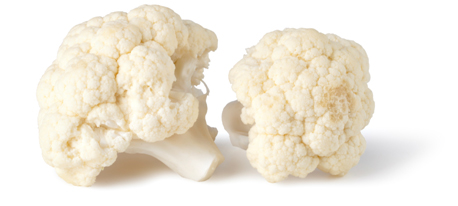
- 1 bunch organic cauliflower, cut into small florets
- Organic olive oil
- Salt and freshly ground black pepper
Directions
Preheat oven to 450 degrees F. Place cauliflower florets onto a large cookie sheet; separate. Drizzle with olive oil. Sprinkle with salt and black pepper. Roast until the vegetable browns on top (about 20 minutes). Enjoy.
If you try one of our suggested recipes, please let us know what you think.
Have your own recipe for a seriously tasty vegetable dish? Share it with us. If we try it and love it, we’ll post your recipe in an upcoming newsletter, give you full credit, and send you a signed copy of Bob’s book as a “thank you.”
New “Live It” Video: More on Colon Cancer Prevention
Loma Linda, CA has been designated a “blue zone” by National Geographic as one of the five communities in the world with the longest-living inhabitants. Residents of Loma Linda are 10 times more likely to make it to 100. So, perhaps we should pay attention to how they live their lives.
Loma Linda University Health’s latest video in the series, “Live It,” is below.
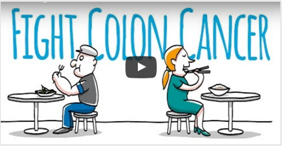 Video: Fight Colon Cancer with Dried Fruit
Video: Fight Colon Cancer with Dried Fruit
Many of you may remember being told as a child to eat your greens because they make you healthy and strong. Well, even as an adult this idea still holds true. In fact, pairing it up with dried fruit, legumes, and brown rice may build a protective barrier against colon cancer.

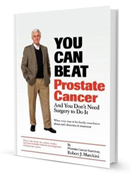
265 Reviews, Position 3 in Amazon, New, Outstanding Reader Comments
Bob Marckini’s book, “You Can Beat Prostate Cancer: And You Don’t Need Surgery To Do It” is still hovering in the #3 position in Amazon on a search for “prostate cancer” out of 34,770 books and has recently surpassed 260 reader reviews—still more than any other book in the top 50.
Below is an excerpt from a recent review written by a periodontist who keeps the book in his waiting room.
A Must Read!! By Dr. Steven Peiser, July 3, 2016
It can be overwhelming to deal with a diagnosis of prostate cancer. Bob Marckini has been there and now runs a worldwide support group. His thoroughness, his knowledge, and his understanding of all topics related to prostate cancer are daunting. His book is well presented, easy to read, and can be treated as a resource manual … His compassion and empathy for prostate cancer victims comes shining through … Marckini is totally there in helping the prostate cancer patient plow through the many paths one can take. He is truly an expert. My own personal experience leaves me with eternal gratitude. As a practicing periodontist, I have a copy of his book in my waiting room with information on how to get the book. I am amazed at how many of my patients’ lives have been affected and altered, and in one case, even rescued, by this book.
Was Bob’s book helpful to you? Have you written an Amazon review yet? If not, please post a review today.
Every Amazon review is important: The more quality reviews, the higher the book ranks within Amazon’s search engine. The higher the ranking, the more visible the book is to those searching for information about prostate cancer treatment options.
Buy Online, in Bulk or in Spanish
Online: Paperback: $19.00--•--Kindle: $9.99--•--NOOK Book: $9.99--•--Apple iBook: $9.99
In Bulk: Conctact us for a discount price list. Proceeds from book sales support proton therapy research through the Robert J. Marckini Endowed Chair at LLUCC.
In Spanish: Buy the print version or in eBook format.

Did You Know …
No Tax Paid
According to the Tax Policy Center, and reported in MarketWatch.com, more than 45 percent of American adults pay no income tax. That means 77.5 million U.S. households owe nothing to the IRS—half because they have no taxable income, and half because they have tax breaks that eliminate their tax liability. The richest 20 percent pay 87 percent of all income tax collected by the IRS.
Americans Living Longer
Researchers at the U.S. National Center for Health Statistics, the CDC, and Prevention Atlanta, reported that death rates for Americans older than 100 fell steadily between 2008 and 2014. More than 72,000 Americans have celebrated 100 birthdays or more. In fact, we have a couple of centenarians within our group.
“Do Not Use New E-15 Gas in Your Car”
E-15 gas is a new, higher blend of ethanol, made from corn. It is EPA approved, is sold in several states, and will soon be sold in many more. Today’s standard gasoline is E-10, which is 10 percent ethanol. E-15 is 15 percent ethanol, and that’s a game changer according to experts.
This new gasoline is reported to do damage to engines in cars, especially those produced before 2012. Triple A says: “Don’t use it because it will damage your engine.” Ten car companies (including BMW, Chrysler, Nissan, Toyota, Ford, Honda, Kia and Mercedes-Benz) say if you use E-15 fuel, it will void your warranty and they will not cover any claims of damage due to this fuel.
“This fuel is approved and pushed by our government,” according to television journalist, Melissa Francis, host of Money with Melissa Francis.
Damage has been reported to fuel systems, gaskets, emission systems, and engines. The new fuel is so corrosive, it must be delivered to gas stations in stainless steel tank trucks (with diesel engines, incidentally).
“Consumers are going to be hurt badly if they use this stuff,” says Lauren Fix, nationally recognized automotive expert. “It’s a little cheaper than standard gasoline, and you might be thinking you’re saving a little money, says Fix, “but it’s going to cost you hundreds, possibly thousands of dollars down the road, because you’re going to have to pay for those repairs.” Not only that, she points out, you don’t get the same gas mileage with E-15 that you get with today’s standard gasolines. So, even if you ignore the potential damage to your car’s engine, the new E-15 gasoline is not cheaper to use.
Back to the Future Series—Part II
Car Insurance 100 Times Cheaper!
A recent editorial in Changing Times made several predictions about how the digital age will impact our future. Here is the second of a series of three articles on this subject:
Autonomous Cars
Self-driving cars are coming fast. In 2018 they will be common. Major change is coming around 2020. You won’t want to own a car. When you need one, you’ll call it up on your iPhone; it will show up and drive you to your destination. You won’t have to park it. You’ll only pay for the distance driven. Our kids will not need drivers’ licenses. We’ll need 90 percent fewer cars. 1.2 million people die each year in traffic accidents. This will drop by at least 1 million. Without accidents, insurance will become 100 times cheaper.
Traditional Car Companies Extinct
Tesla, Apple and Google will be right in the middle of this. Most traditional car companies could become bankrupt. People will move farther away from the city to live in desirable neighborhoods because they can work while they commute.
Cheap Electricity
Electric cars will gradually replace combustion engine cars. They will be quieter and cleaner. Solar power will become mainstream for charging cars and provide home power. Electricity will be incredibly cheap.
Abundant Water
Water will be cheap and abundant because cheap electricity will allow desalination of seawater.
Healthcare Changes
A new medical device called a Tricorder, which works with your iPhone, will be cheap and can be used for retina scan, blood samples, and breath samples. It will analyze 54 biomarkers to identify almost any disease. Everyone will have access to world-class medicine, nearly for free.

Last Month's Brain Teaser
What is the largest number of states a candidate can lose and still win the presidential election?
Answer: According to Parade Magazine, the answer is 39. Even if a candidate doesn’t get a single vote in 39 states (or DC) they’re the next president as long as they win the popular vote in these 11 states: California, New York, Texas, Florida, Pennsylvania, Illinois, Ohio, Michigan, New Jersey, North Carolina and Georgia.
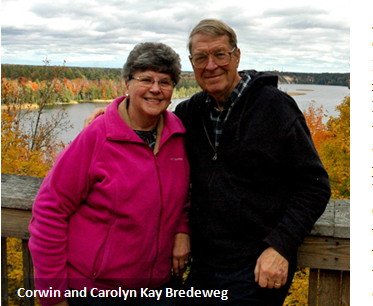 Winner: The winner for July/August is BOB member Corwin Bredeweg from Midland, MI. Corwin, a retired research chemist for Dow Chemical Company, was diagnosed with prostate cancer and treated with proton therapy at Loma Linda University Cancer Center (LLUCC) in 2011. He feels thankful that he has reached the “five year milestone,” with a low PSA and a quality of life that he enjoys
Winner: The winner for July/August is BOB member Corwin Bredeweg from Midland, MI. Corwin, a retired research chemist for Dow Chemical Company, was diagnosed with prostate cancer and treated with proton therapy at Loma Linda University Cancer Center (LLUCC) in 2011. He feels thankful that he has reached the “five year milestone,” with a low PSA and a quality of life that he enjoys
How Wednesday Night Meetings at LLUCC May Have Saved His Life
Corwin told us an interesting story. Prior to being diagnosed with prostate cancer, he had recently recovered from a quadruple bypass heart surgery in the fall of 2010. That was his second major heart attack.
After being diagnosed with prostate cancer, his urologist placed him on his schedule for a prostatectomy. Corwin’s questions about proton therapy were met with skepticism. His doctor told him that “proton radiation was very risky and relatively new.” Since Corwin had some time before surgery, he did his own research into alternative treatment options. “Out of about 20 books that I read, one book stood out amongst all the others—Bob Marckini’s book, “You Can Beat Prostate Cancer: And You Don’t Need Surgery To Do It.” After devouring just half the book, Corwin told his wife, Carolyn Kay, “I found my treatment option—proton therapy.” After being accepted at LLUCC, Corwin canceled his surgery appointment.
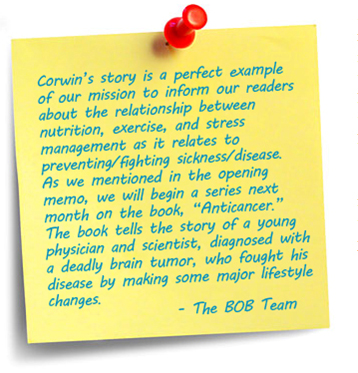 During treatment, Corwin and Carolyn attended a meeting every Wednesday evening as part of the LLUCC proton program. They listened to Dr. Hans Diehl, best-selling author, researcher, and clinical professor of preventive medicine at Loma Linda University, lecture on health-related topics. One topic in particular stood out—how diet can affect your health, including various diseases … like heart disease. Dr. Diehl suggested attendees read “The China Study” by T. Colin Campbell (We have recommended this book, along with Dr. Diehl’s book, “Health Power: Health by Choice Not Chance,” several times in our newsletter).
During treatment, Corwin and Carolyn attended a meeting every Wednesday evening as part of the LLUCC proton program. They listened to Dr. Hans Diehl, best-selling author, researcher, and clinical professor of preventive medicine at Loma Linda University, lecture on health-related topics. One topic in particular stood out—how diet can affect your health, including various diseases … like heart disease. Dr. Diehl suggested attendees read “The China Study” by T. Colin Campbell (We have recommended this book, along with Dr. Diehl’s book, “Health Power: Health by Choice Not Chance,” several times in our newsletter).
It’s interesting to note that Dr. Diehl is also the founder of The Coronary Health Improvement Program (CHIP)—a lifestyle enrichment program designed to reduce disease risk factors through the adoption of better health habits and appropriate lifestyle modifications.
Upon returning home from treatment, Corwin read “The China Study.” “It opened my eyes to a whole new world of research," he said. "I was particularly interested in how diet can influence heart disease, even to the extent that heart disease could be reversed.” This was something his cardiologist had never told him. He was told simply to take pills and eat a low fat diet.
Corwin went on to read numerous other books about diet and nutrition. “I have come to the conclusion that a healthy lifestyle is one of a three legged stool. Without including all three in your life, the stool falls over. The three legs are: A healthy diet, appropriate exercise, and stress management. In his case, incorporating these three things into my life made more sense than simply taking pills as a bandage for an underlying problem,” Corwin said. “This has not only changed my life but also many of my family members as well.”
Corwin is in the process of writing a book on his findings!
New Brain Teaser: A Tough One
Which of the following names does not belong: a) October, b) the Dead Sea, C) Greenland, d) the West Indies, or e) Li’l Abner? (Hint: Think Negative)
Send your brain teaser answers to [email protected] for a chance to win a signed copy of Bob’s book.
Math Question
Mrs. Applebee, the 6th grade teacher, posed the following problem to one of her math classes: “A wealthy man dies and leaves $20 million. One-tenth is to go to his wife; one-tenth is to go to his son; one-sixth to his butler; one-seventh to the maid; and the rest goes to charity. Now … what does each get?”
After a long silence in the classroom, little Johnny raised his hand. With complete sincerity in his voice, he answered, “A good lawyer.”
Talking Parrot
A woman went to a local pet store and purchased a parrot that was guaranteed to talk. After a week, she returned to the pet store to complain about that he didn’t say a word. The pet store owner suggested she purchase a mirror and hang it in the cage, because he felt the bird might talk if he saw himself in the mirror.
A week later the woman returned to the pet store with the same complaint. Next, the owner suggested she purchase a swinging perch, thinking that might help. It didn’t. Each week she tried something different: A tiny ladder, a bird bath, a warm lamp, etc.
Finally after two months, she visited the pet store and told the owner the parrot had died. “Did he say anything before he died?” the owner asked.
“Yes,” she said, “He said, ‘Does that pet store sell any food?’”
Incredible Golf Opportunity
I have two tickets to the U.S. Open final round, but just realized I’m getting married that day and can’t go. If you’re interested in going in my place, it’s at St. Paul’s Church and her name is Emily.
It’s All Relative
Smith climbs to the top of Mt. Sinai to get close enough to talk to God. Looking up, he asks the Lord, “God, what does a million years mean to you?”
The Lord replies, “A minute.” Smith asks, “And what does a million dollars mean to you?”
The Lord replies, “A penny.” Smith asks, “Can I have a penny?” The Lord replies, “In a minute.”


Real Stories that Teach You Many Things in Life (Author unknown)
- I interviewed my grandmother for part of a research paper I’m working on for my psychology class. When I asked her to define success in her own words, she said, “Success is when you look back at your life and the memories make you smile.”
- I asked my mentor—a very successful businessman in his 70s—what his top three tips are for success. He smiled and said, “Read something no one else is reading; think something no one else is thinking; and do something no one else is doing.”
- After I watched my dog get run over by a car, I sat on the side of the road holding him and crying. And just before he died, he licked the tears off my face.
- Today, when I witnessed a 27-year-old breast cancer patient laughing hysterically at her 2-year-old daughter’s antics, I suddenly realized that I need to stop complaining about my life and start celebrating it again.
- I was traveling in Kenya and met a refugee from Zimbabwe. He said he hadn’t eaten anything in over three days and looked extremely skinny and unhealthy. Then my friend offered him the rest of the sandwich he was eating. The first thing the man said was, “We can share it.”
The best sermons are lived, not preached.
Low PSAs to all!
Bob Marckini and Deb Hickey
To print the BOB Tales newsletter or view the newsletter with a larger font size, click here for the PDF file.
NO MEDICAL ADVICE: Material appearing here represents opinions offered by non-medically-trained laypersons. Comments shown here should NEVER be interpreted as specific medical advice and must be used only as background information when consulting with a qualified medical professional.

